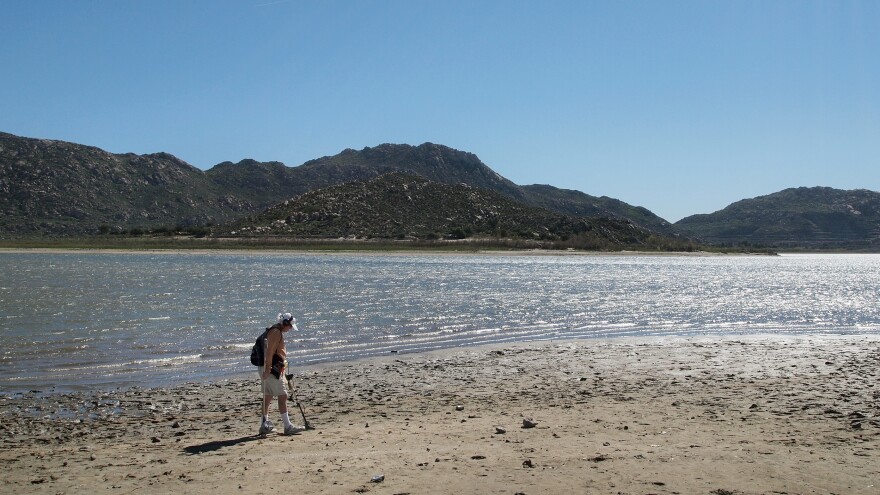The message from park rangers, amateur metal detectors and regular fisherman at California's Lake Perris is unanimous: The water is lower than they've ever seen it.
The state's severe ongoing drought has affected everything from agriculture to urban life. Here, the impact is made visible. As the water level has dropped, sunken treasures, trash and forgotten boats have risen above the surface.
Last fall, rangers at the Lake Perris State Recreation Area and reservoir began spotting clumps of massive tractor tires peeking above the water on one section of the lake.
One park employee refers to the dozens of tires as "the serpent," because of the curving profile the tires create against the water, kind of like a Loch Ness monster made of rubber. According to state park superintendent John Rowe, the appearance of "the serpent" — or the "tire reef," as it's more officially known — was not a surprise.
"It's been on all of our maps to begin with," Rowe says.
When Lake Perris Dam was built in the early 1970s, according to Rowe, old and worn-out tires from the heavy construction equipment were left over. So the state Department of Fish and Wildlife placed the tires in the water as a habitat for bass.

For 40 years, the tire reef fulfilled that mandate. The RiversidePress-Enterprise first reported the appearance of the tires, and local fishermen told the paper that the man-made reef had been a great fishing spot.

Under normal circumstances, the tires would sit deep under water.
"Typically, at high pool, that tire reef is under 30 feet of water, [or] 35 feet of water," says Rowe.
But the water level is now more than 40 vertical feet below normal.
The drought is not solely responsible for that dramatic drop: Problems with the dam forced the water level down about 25 feet in 2005. The drought is responsible for the remainder.
That receding water level has also revealed at least eight sunken, and forgotten, boats.
"All of the boats we're finding," Rowe says, are "well over 12 years old," and they likely went unreported at the time of sinking.
"We get a lot of boats, and a lot of trash, lawn chairs, stuff like that," says Officer Javier Garza, a ranger at Lake Perris.
Despite the drought, the recreation area remains open to boaters, fishermen and the occasional amateur metal detectorist.
Marty Gabriel, a retired truck driver, often comes down to Lake Perris with a metal detector and scoop, and has been visiting the lake since the early 1990s. He says the drought has "cut down on the volume of people down here." But despite the expanding shoreline — which you might think is fertile territory for metal detecting — Gabriel says the treasures beneath the sand aren't that much more interesting.
He prefers the old, fuller Lake Perris.
"It is what it is," he says. "We definitely need rain, and they need to fix the dam to make this place usable again."
Dam repairs are currently underway, but park superintendent John Rowe says Lake Perris also needs the cooperation of Californians and mother nature.
"The message is conservation," he says, "and pray for rain."
Copyright 2021 NPR. To see more, visit https://www.npr.org. 9(MDAxODg3MTg0MDEyMTg2NTY3OTI5YTI3ZA004))




